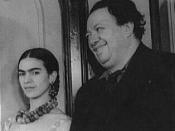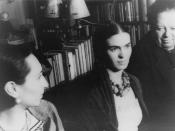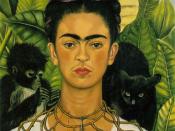Production Techniques Unite Art and Passion in 'Frida'
Julie Taymor muses that 'passion and art become synonymous' in her biopic about Mexican artist and revolutionary Frida Kahlo. The künstlerfilme 'Frida' transcends Kahlo's inspirational and turbulent life through the use of a range of production techniques. These techniques include colour, sound, tableaux vivant and cinematography, and to a large extent help to develop Kahlo's passionate character. Kahlo lived through the first half of the 20th century and was a force of nature, painting modern surrealist self portraits, which were based upon her own reality. This vibrant character in conjunction with Taymor's artistic methods help to convey Kahlo's powerful lessons on the truth about humanity and its lasting features.
Cinematography is the first main technique that helps to develop the protagonist Kahlo. At age 18 she was involved in a horrific bus accident, a life-changing experience which realised her birth as an artist.
This nadir was completely shot from inside the bus; advantageous as a clear way of showing Kahlo's point of view. Taymor exploits the use of close up facial reaction shots to unfold the drama, expressively portrayed by the actor Salma Hayek. Seconds before the accident the camera trains on a blue parrot and the gold dust a 'blue collar' man possesses, a subtle note exhibiting how Kahlo notices things of beauty. As the bus approaches the building, slow motion is combined with a cacophony of non-diegetic sound - smashing glass, the flapping bird's wings, and finally an ethereal wail of female voices. Through a low angle shot we view bright oranges bouncing over the dark chaos of broken timber and jolting feet, the low angle heightening the impact of the collision in which what goes up evidently comes down. This is followed by a low angle of Kahlo...


